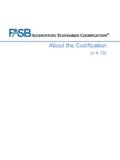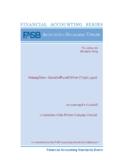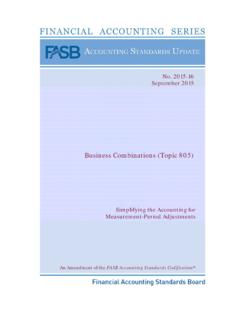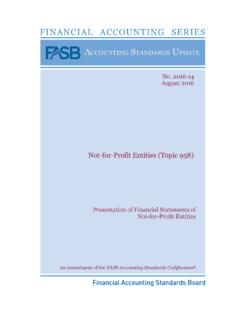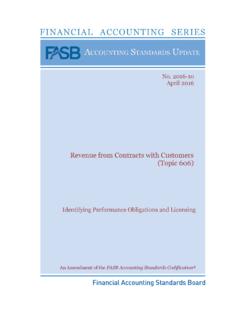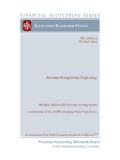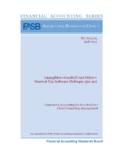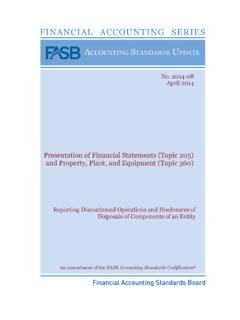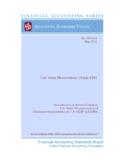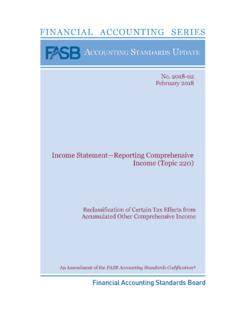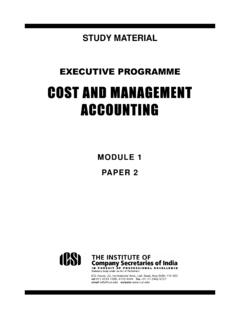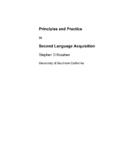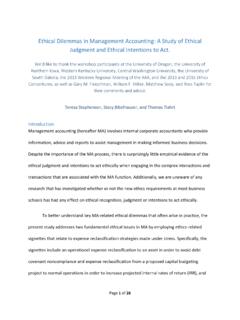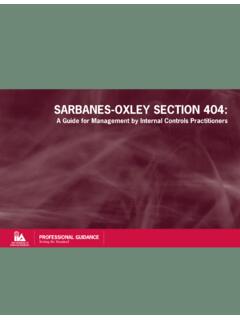Transcription of No. 2015-11 July 2015 - FASB Accounting Standards ...
1 Inventory (Topic 330) No. 2015-11 July 2015 Simplifying the Measurement of Inventory An Amendment of the FASB Accounting Standards Codification The FASB Accounting Standards Codification is the source of authoritative generally accepted Accounting principles (GAAP) recognized by the FASB to be applied by nongovernmental entities. An Accounting Standards Update is not authoritative; rather, it is a document that communicates how the Accounting Standards Codification is being amended. It also provides other information to help a user of GAAP understand how and why GAAP is changing and when the changes will be effective. For additional copies of this Accounting Standards Update and information on applicable prices and discount rates contact: Order Department Financial Accounting Standards Board 401 Merritt 7 PO Box 5116 Norwalk, CT 06856-5116 Please ask for our Product Code No. ASU2015-11.
2 FINANCIAL Accounting SERIES (ISSN 0885-9051) is published quarterly by the Financial Accounting Foundation. Periodicals postage paid at Norwalk, CT and at additional mailing offices. The full subscription rate is $242 per year. POSTMASTER: Send address changes to Financial Accounting Standards Board, 401 Merritt 7, PO Box 5116, Norwalk, CT 06856-5116. | No. 418 Copyright 2015 by Financial Accounting Foundation. All rights reserved. Content copyrighted by Financial Accounting Foundation may not be reproduced, stored in a retrieval system, or transmitted, in any form or by any means, electronic, mechanical, photocopying, recording, or otherwise, without the prior written permission of the Financial Accounting Foundation. Financial Accounting Foundation claims no copyright in any portion hereof that constitutes a work of the United States Government. An Amendment of the FASB Accounting Standards Codification No.
3 2015-11 July 2015 Inventory (Topic 330) Simplifying the Measurement of Inventory Accounting Standards UpdateFinancial Accounting Standards Board Accounting Standards Update 2015-11 Inventory (Topic 330) Simplifying the Measurement of Inventory July 2015 CONTENTS Page Numbers Summary .. 1 2 Amendments to the FASB Accounting Standards Codification .. 3 25 Background Information and Basis for Conclusions .. 26 30 Amendments to the XBRL Taxonomy .. 31 1 Summary Why Is the FASB Issuing This Accounting Standards Update (Update)? The Board is issuing this Update as part of its Simplification Initiative. The objective of the Simplification Initiative is to identify, evaluate, and improve areas of generally accepted Accounting principles (GAAP) for which cost and complexity can be reduced while maintaining or improving the usefulness of the information provided to users of financial statements. The Board heard from stakeholders that the guidance on the subsequent measurement of inventory is unnecessarily complex because there are several potential outcomes.
4 Topic 330, Inventory, currently requires an entity to measure inventory at the lower of cost or market. Market could be replacement cost, net realizable value, or net realizable value less an approximately normal profit margin. Who Is Affected by the Amendments in This Update? The amendments in this Update do not apply to inventory that is measured using last-in, first-out (LIFO) or the retail inventory method. The amendments apply to all other inventory, which includes inventory that is measured using first-in, first-out (FIFO) or average cost. The Board received feedback from stakeholders that the proposed amendments would reduce costs and increase comparability for inventory measured using FIFO or average cost but potentially could result in significant transition costs that would not be justified by the benefits for inventory measured using LIFO or the retail inventory method due to the complexity inherent in those methods.
5 Therefore, the Board decided to limit the scope of the simplification to exclude inventory measured using LIFO or the retail inventory method. What Are the Main Provisions? An entity should measure inventory within the scope of this Update at the lower of cost and net realizable value. Net realizable value is the estimated selling prices in the ordinary course of business, less reasonably predictable costs of completion, disposal, and transportation. Subsequent measurement is unchanged for inventory measured using LIFO or the retail inventory method. The amendments in this Update more closely align the measurement of inventory in GAAP with the measurement of inventory in International Financial Reporting Standards (IFRS). 2 The Board has amended some of the other guidance in Topic 330 to more clearly articulate the requirements for the measurement and disclosure of inventory. However, the Board does not intend for those clarifications to result in any changes in practice.
6 Other than the change in the subsequent measurement guidance from the lower of cost or market to the lower of cost and net realizable value for inventory within the scope of this Update, there are no other substantive changes to the guidance on measurement of inventory. When Will the Amendments Be Effective and What Are the Transition Requirements? For public business entities, the amendments in this Update are effective for fiscal years beginning after December 15, 2016, including interim periods within those fiscal years. For all other entities, the amendments in this Update are effective for fiscal years beginning after December 15, 2016, and interim periods within fiscal years beginning after December 15, 2017. The amendments in this Update should be applied prospectively with earlier application permitted as of the beginning of an interim or annual reporting period. 3 Amendments to the FASB Accounting Standards Codification Introduction 1.
7 The Accounting Standards Codification is amended as described in paragraphs 2 25. In some cases, to put the change in context, not only are the amended paragraphs shown but also the preceding and following paragraphs. Terms from the Master Glossary are in bold type. Added text is underlined, and deleted text is struck out. Amendments to Master Glossary 2. Amend the Master Glossary term Direct Effects of a Change in Accounting Principle, with a link to transition paragraph 330-10-65-1, as follows: [Note: The term Net Realizable Value is shown for convenience.] Direct Effects of a Change in Accounting Principle Those recognized changes in assets or liabilities necessary to effect a change in Accounting principle. An example of a direct effect is an adjustment to an inventory balance to effect a change in inventory valuation method. Related changes, such as an effect on deferred income tax assets or liabilities or an impairment adjustment resulting from applying the subsequent measurement guidance in Subtopic 330-10 lower-of-cost-or-market test to the adjusted inventory balance, also are examples of direct effects of a change in Accounting principle.
8 Net Realizable Value Estimated selling prices in the ordinary course of business, less reasonably predictable costs of completion, disposal, and transportation. Amendments to Subtopic 330-10 3. Supersede paragraph 330-10-35-1 and its related heading and paragraph 330-10-35-6, add paragraphs 330-10-35-1A through 35-1C and 330-10-35-7A and their related headings, and amend paragraphs 330-10-35-2 and 330-10-35-8 through 35-11, with a link to transition paragraph 330-10-65-1, as follows: 4 Inventory Overall Subsequent Measurement > Adjustments to Lower of Cost or Market 330-10-35-1 Paragraph superseded by Accounting Standards Update 2015-11 . A departure from the cost basis of pricing the inventory is required when the utility of the goods is no longer as great as their cost. Where there is evidence that the utility of goods, in their disposal in the ordinary course of business, will be less than cost, whether due to physical deterioration, obsolescence, changes in price levels, or other causes, the difference shall be recognized as a loss of the current period.
9 This is generally accomplished by stating such goods at a lower level commonly designated as market. [Content amended and moved to paragraph 330-10-35-1C] 330-10-35-1A The subsequent measurement of inventory depends on the cost method and is different for the following: a. Inventory measured using any method other than last-in, first-out (LIFO) or the retail inventory method (see paragraph 330-10-35-1B) b. Inventory measured using LIFO or the retail inventory method (see paragraphs 330-10-35-1C through 35-7). Paragraphs 330-10-35-7A through 35-11 apply to all inventory. > Inventory Measured Using Any Method Other Than LIFO or the Retail Inventory Method 330-10-35-1B Inventory measured using any method other than LIFO or the retail inventory method (for example, inventory measured using first-in, first-out (FIFO) or average cost) shall be measured at the lower of cost and net realizable value. When evidence exists that the net realizable value of inventory is lower than its cost, the difference shall be recognized as a loss in earnings in the period in which it occurs.
10 That loss may be required, for example, due to damage, physical deterioration, obsolescence, changes in price levels, or other causes. > Inventory Measured Using LIFO or the Retail Inventory Method 330-10-35-1C A departure from the cost basis of pricing the {remove glossary link}inventory{remove glossary link} measured using LIFO or the retail inventory method is required when the utility of the goods is no longer as great as their cost. Where there is evidence that the utility of goods, in their disposal in the ordinary course of business, will be less than cost, whether due to damage, physical deterioration, obsolescence, changes in price levels, or other causes, the 5 difference shall be recognized as a loss of the current period. This is generally accomplished by stating such goods at a lower level commonly designated as market. [Content amended as shown and moved from paragraph 330-10-35-1] 330-10-35-2 The cost basis of recording inventory ordinarily achieves the objective of a proper matching of costs and revenues.
